“Pain demands to be felt.”
–John Green, The Fault in Our Stars
When we decided to go to the Oklahoma City National Memorial, I truly didn’t think much about it. I thought, “we like museums” and “I heard there’s a lovely lawn with some commemorative chairs or something?”
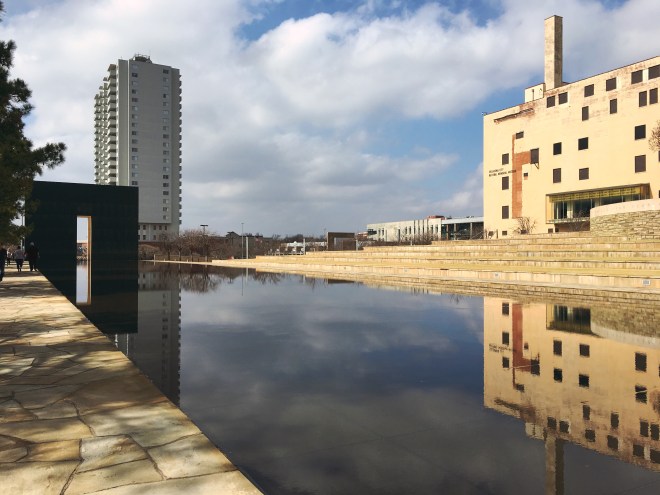
“If nothing else,” I thought, “I’ll get a few good photos.” I underestimated everything.
When you arrive you walk through the gates—across the top, facing the street are emblazoned the words, “We come here to remember those who were killed, those who survived and those changed forever. May all who leave here know the impact of violence. May this memorial offer comfort, strength, peace, hope, and serenity.” If this is the mission statement—they have done their due diligence.
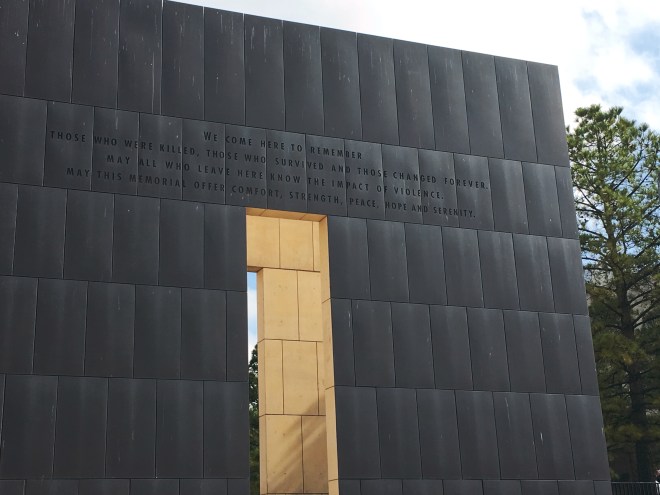
Please check out the website that talks about all the symbolic elements contained within the outdoor memorial as there’s no way I can cover it all. But there are a few things that I’ll tell you about which hit me the hardest: The formal entrances, one at each end, contain the times 9:01 and 9:03—which mark the time before and after when the bombs went off. Everything you’re about to see and experience is because of the space between those three minutes contained in this space.
I walked in and saw the reflection pool right in front of me and the lawn with chairs to my right. To the left was a building that sat across the street from the bombing site—this is where the museum itself is, now. My knees instantly buckled and I was hit, fiercely, with the awareness that real, true evil was done here even though it doesn’t look like it at all. Three minutes of pure evil. But more than that–from that moment forward, for 22 years: all love. Only love. Powerful love that has done enormous things.

There’s something about that ground—that space. There’s something holy there. Ryan told me at one point, “I don’t believe in ghosts or spirits or things like that… but there is something here.” There’s something there. Something that demands to be felt.
The lawn houses 168 chairs that represent the lives lost in the terrorist attack. There are nine rows—representing the nine floors of the building to show where each person was when their life was taken. This explains why certain areas of the lawn are more densely populated with chairs than other spots. As we were walking around, I couldn’t help but see this one little girl, sitting on the grass among the chairs. Surely she didn’t really understand what was done here, right? Surely she didn’t know. All I could think when I looked at her sitting there was, “it could have been you.” So many children were lost in the bombing. I wanted to run to her and beg her not to sit right there because it was just too real for me to deal with. But I snapped a photo to keep because it’s important to see this as something real. To remember that these were real people with lives and parents and babies and pets and jobs and friends who loved them fiercely.


Walking around the back of the lawn, I was wondering why they’d surround this beautiful space with such a jankey wall with busted concrete and rusted iron poking through it. And it all came to me so slowly but I realized—my God. I’m in the basement right now. I’m standing in the building that was destroyed. I’m standing here among all that debris that I saw on TV when I was a kid. I’m standing here where all these people died. I’m standing here where heroes were born. I have the opportunity to stand here because we don’t pretend this shit doesn’t happen—we don’t turn away from it. I’m standing here in this space that other people cleaned out and made beautiful so that I’ll stand up when this happens again.
What am I going to do when this happens again?

We walked into the museum and it follows a very specific flow. You start on the top floor and the first exhibits you see are about how this is a day like any other day. It talks about the weather and the stock prices and the morning news that day. You learn about how there have been a resurgence in hate groups in the 90’s. And at the end of the first exhibit, you find yourself watching a TV—a group of people are being interviewed about some trial they’re about to have? It’s supposed to start at 9:00 am. And at 9:00 am, a door opens and you go inside. You’re witnessing this trial take place. You hear an actual recording of this actual trial that was going on at 9:00 am on April 19, 1995. This recording that picked up the sound of the blast across the street. I knew the sound of the blast was coming but I was not prepared for the volume or the clarity of this tape recording… It was so loud. It was not normal.
From that point on, the museum follows a very thorough plan. The doors of the trial room open and you find yourself in the next exhibit that focuses on the destruction. You hear the sound of sirens and helicopters. You see debris everywhere. It feels like you’re in it. It is very overwhelming. My heart was racing but I forced myself to stay and look at what was in front of me. This was difficult for me to bear witness to but over twenty years ago this—and so much more—was the reality that so many people were living in. This first exhibit featured real-life everyday things that were found in the rubble. I was struck most by the day planner that was found. It belonged to Terry Smith Rees who died in the attack. Maybe it’s because I hold so tightly to my day-planner? I just felt such a kinship with that person. Over and over and over again, in my mind, played “there but by the grace of God go I.”
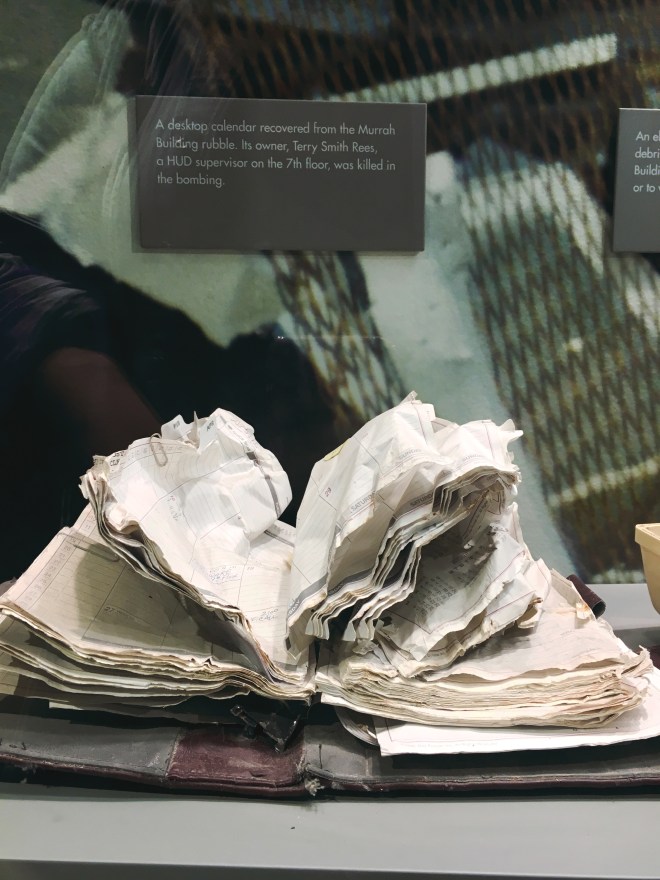
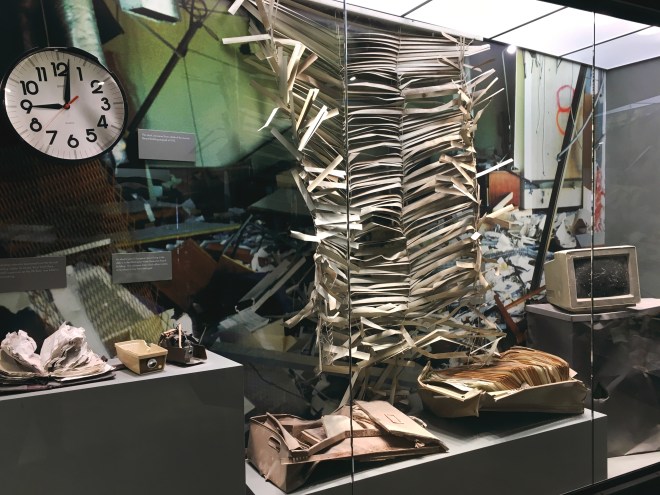
This exhibit led to another exhibit that featured interviews with survivors—talking about what it was like to be stuck and what it was like to be found. Talking about what their friends were like. I was overwhelmed when I saw a display of a woman’s dress. It had the tiniest rip in it—belonging to a woman who was in the middle of a meeting when her colleges across the table “just disappeared.” She made it out—just sitting at the other end of the meeting table, though I believe that she was stuck for a while in the collapse. I’ve thought about what that must have been like every day since our visit.

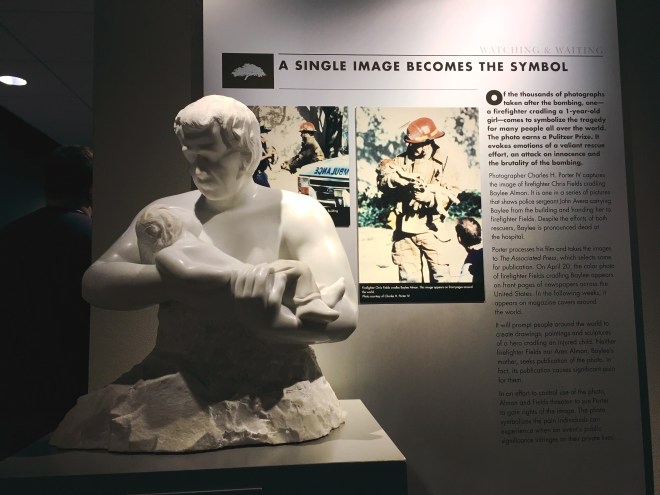
Just when I thought I couldn’t take any more destruction, the sky opened up and you get to focus on hope. Next up is a section all about how the news anchors were covering it—what information they were given, what everyone assumed, what they were wrong about and generally how they felt about it.
There’s a section all about the rescue efforts—how they had to brace the building so that they could go in and recover but they didn’t want the building to keep falling. I remember seeing one sign that talked about how the hospitals all around were prepped for a mass incoming of survivors but it was actually slow-going to get to them. There was so much work that went into getting everyone out and accounted for.

Throughout each exhibit, there are computers off to the side where you can learn more about the people involved in each exhibit. At first you can learn more about each individual victim. Further on, there are computers where you can learn about the survivors. Up ahead, you can learn about the rescue teams. It was an excellent opportunity for people who just wanted to know a little bit more.
The next floor dealt a bit with Timothy McVeigh and Terry Nichols. Even though I couldn’t stop wondering why–I didn’t care to spend too much time thinking about these people so I didn’t spend a lot of time here. They do have McVeigh’s get-away car on display, though. Complete without a license plate. He was arrested in the first place because he was driving a car with no tag. There’s a part of me that was satisfied that a man who put so much time, thought and energy into something like this got picked up on something so minor. I’m sure it was an intentional choice on his part but he lost that bet.

But my most favorite part of the whole museum was at the very end. A room filled with photos of those lost in the bombing. Over the speaker—their names are being read. All day long, their names are read–their faces are seen. They’re not forgotten and they’re not lost in vain. They’re here in this hall and living in the strength and determination that we waked out of there with.



And as you leave the museum, you’re confronted with these words, again:
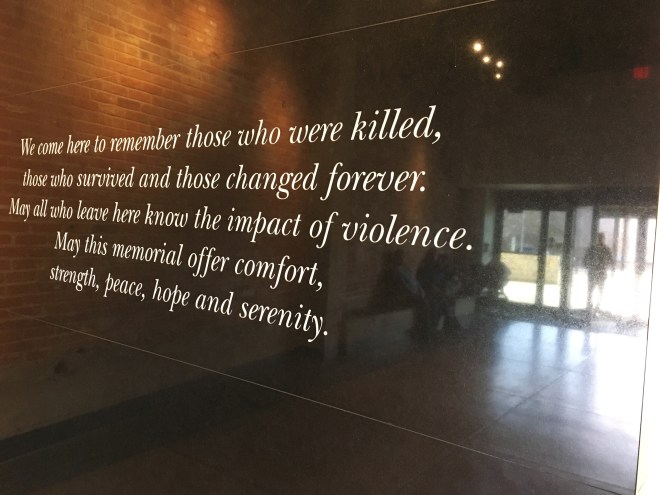
Go in peace and in the strength to run in the direction of the crumbling buildings.
XOXO, Lib
Save
Beautiful!
I’ve still never been here. My dad lost a dear friend in this tragedy and I don’t know how I’d handle seeing the photos and personal artifacts. Thanks for sharing, Libby.
[…] We also really wanted to see the Oklahoma City National Memorial Museum, too. I’ve dedicated a whole post to what we experienced there. But in this post I’ll let you know about a few places that we ate […]